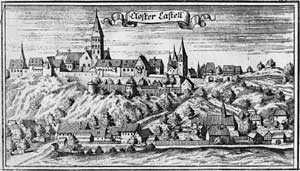Biburg Abbey was a Benedictine monastery located at Biburg in Bavaria, Germany.
Echenbrunn Abbey was a Benedictine monastery located at Echenbrunn, now part of Gundelfingen an der Donau in Bavaria, Germany.

Frauenzell Abbey was a Benedictine monastery situated in Frauenzell, which is part of Brennberg in Bavaria, Germany.
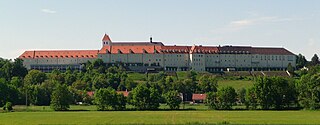
Mallersdorf Abbey was formerly a monastery of the Benedictine Order and is now a Franciscan convent in Mallersdorf-Pfaffenberg in Bavaria.

Oberalteich Abbey was a Benedictine monastery in Bogen, Bavaria, Germany.
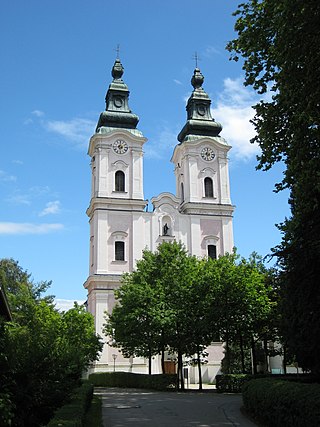
Vornbach Abbey was a Benedictine monastery in Neuhaus am Inn in Bavaria, Germany.
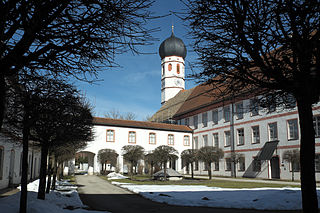
Beuerberg Abbey, formerly a monastery of the Augustinian Canons, is now the Monastery of the Visitation, Beuerberg, a community of the Visitandines in Eurasburg in Bavaria, Germany.

Prüfening Abbey was a Benedictine monastery on the outskirts of Regensburg in Bavaria, Germany. Since the beginning of the 19th century it has also been known as Prüfening Castle. Notably, its extant dedicatory inscription, commemorating the founding of the abbey in 1119, was created by printing and is a unique document of medieval typography.

Elchingen Abbey was a Benedictine monastery in Oberelchingen in Bavaria, Germany, in the diocese of Augsburg.
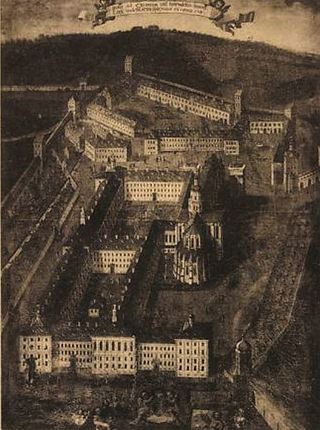
The Imperial Abbey of Kaisersheim, was a Cistercian monastery in Kaisersheim, Bavaria, Germany.

Banz Abbey, now known as Banz Castle, is a former Benedictine monastery, since 1978 a part of the town of Bad Staffelstein north of Bamberg, Bavaria, southern Germany.
Klarenthal Abbey is a former convent of the Order of Poor Ladies in the borough of Klarenthal in Wiesbaden, Germany. Klarenthal is the only abbey in present-day Wiesbaden.
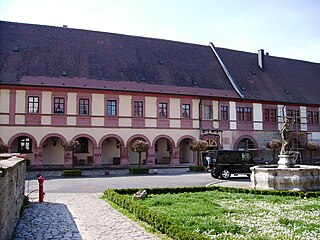
Tückelhausen Charterhouse is a former Carthusian monastery, or charterhouse, in Ochsenfurt in Bavaria, Germany.

Astheim Charterhouse, also known as Marienbrück Charterhouse, was a Carthusian monastery, or charterhouse, in Astheim near Volkach in Kitzingen, Bavaria, Germany.

Michaelsberg Abbey or Michelsberg Abbey, also St. Michael's Abbey, Bamberg is a former Benedictine monastery in Bamberg in Bavaria, Germany. After its dissolution in 1803 the buildings were used for the almshouse Vereinigtes Katharinen- und Elisabethen-Spital, which is still there as a retirement home. The former abbey church remains in use as the Michaelskirche.
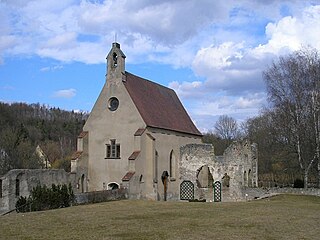
Christgarten Charterhouse is a former Carthusian monastery, or charterhouse, near Ederheim in Bavaria, Germany.
Count Berengar II of Sulzbach, sometimes known as Berengar I of Sulzbach, was Count of Sulzbach in Bavaria. Berengar was a leader of the reform party. He sided with Pope Gregory VII during the Investiture Controversy in opposition to Henry IV, Holy Roman Emperor, and supported Henry V in his successful rebellion against his father. He is known as the founder of several abbeys.

Münchsmünster Abbey was a monastery in Münchsmünster, Upper Bavaria, in the Electorate of Bavaria. It was closed in 1556 during the Protestant Reformation, and later was administered by Jesuits and then the Knights of Malta before being auctioned in 1817 and largely demolished. Some fragments have been preserved.

The Collegiate Church of Saints Philip and James, Altötting, with the associated college or community of secular canons, was founded in about 1228 in Altötting, Bavaria, southern Germany.

Hornbach Abbey is a former monastery founded around 741 in the historic town of Gamundias by Saint Pirmin, which soon became a Benedictine abbey. The most important neighbouring abbeys were Bausendorf, Saint-Avold, Glandern, Villers-Bettnach, Fraulautern, Mettlach, Tholey, and the stift of St. Arnual. The neighboring spiritual centers were Trier and Metz. At present, all that remains of Hornbach Abbey are the structural remains of the convent buildings, which have been supplemented by a monastery museum, and a modern chapel with the historical tomb of the monastery's founder.
